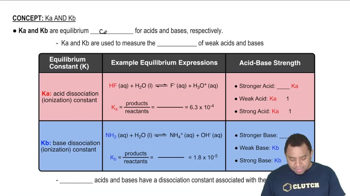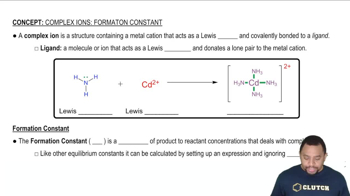Here are the essential concepts you must grasp in order to answer the question correctly.
Solubility Product Constant (Ksp)
The solubility product constant (Ksp) is an equilibrium constant that applies to the dissolution of sparingly soluble ionic compounds. It quantifies the extent to which a compound can dissolve in water, represented by the concentrations of its ions at equilibrium. For Ag2S, Ksp indicates the product of the concentrations of Ag+ and S2- ions in a saturated solution, which is crucial for understanding its solubility in the context of the given reaction.
Recommended video:
Solubility Product Constant
Acid Dissociation Constants (Ka)
The acid dissociation constant (Ka) measures the strength of an acid in solution, indicating how well it donates protons (H+) to water. For H2S, Ka1 and Ka2 represent the dissociation of the acid into H+ and HS-, and then HS- into H+ and S2-, respectively. These constants are essential for calculating the equilibrium concentrations of species in the reaction, particularly in determining the formation of H2S from the dissociation of H+ ions.
Recommended video:
Characteristics of Ka and Kb
Formation Constant (Kf)
The formation constant (Kf) describes the stability of a complex ion formed from a metal ion and ligands in solution. In this case, Kf for AgCl2^- indicates the extent to which silver ions (Ag+) react with chloride ions (Cl-) to form the complex ion. Understanding Kf is vital for calculating the equilibrium constant for the overall reaction, as it reflects the favorability of complex formation in the presence of Cl- ions.
Recommended video:
Complex Ions and Formation Constant
 Verified step by step guidance
Verified step by step guidance

